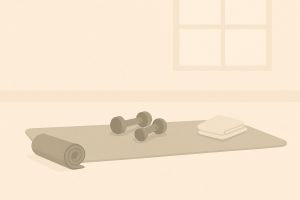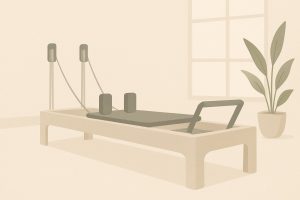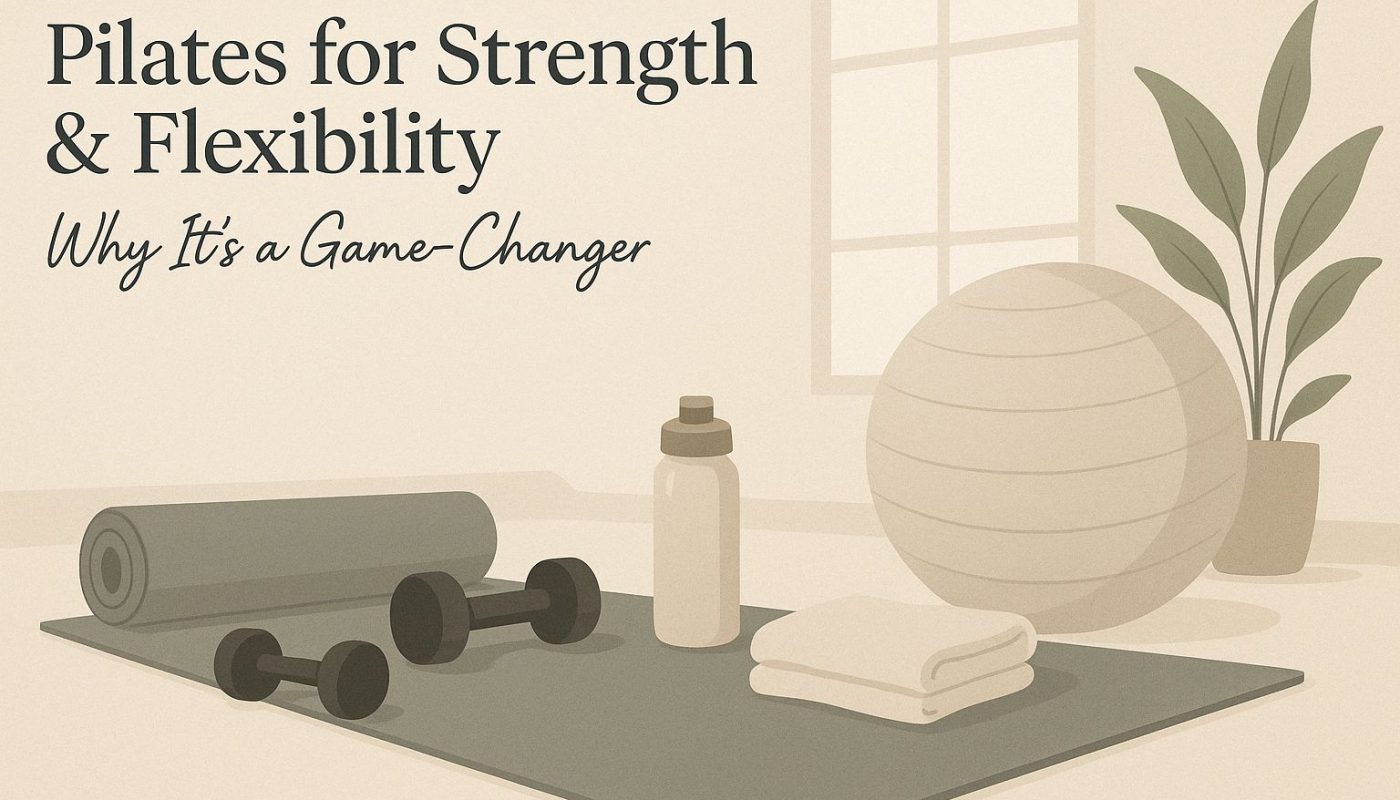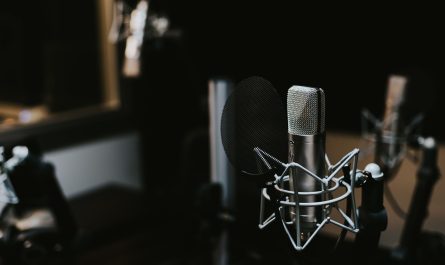Pilates has become one of the most popular forms of exercise in recent years, and for good reason. Known for its focus on core strength, flexibility, and overall body control, Pilates is a full-body workout that can benefit people of all ages and fitness levels. Whether you’re new to Pilates or just curious about what it’s all about, this post will cover everything you need to know to get started.
What’s Pilates ?
Pilates is a physical fitness system designed to improve flexibility, strength, posture, and mental awareness. Created by Joseph Pilates in the early 20th century, it focuses on low-impact, controlled movements that enhance core strength, balance, and coordination.
There are two main types of Pilates: mat Pilates and reformer Pilates.
 Mat Pilates: This form is performed on a mat, using your body weight as resistance. The focus is on strengthening your core, but it also works the entire body, improving posture, alignment, and flexibility.
Mat Pilates: This form is performed on a mat, using your body weight as resistance. The focus is on strengthening your core, but it also works the entire body, improving posture, alignment, and flexibility.
Reformer Pilates: This version is done using a machine called the reformer, which has a sliding platform, springs, and adjustable resistance. It allows for more advanced movements and can help target deeper muscles for a more dynamic workout.
Both forms have their unique benefits and they share the same principles: controlled movements, breath awareness, and mindfulness. I love reformer pilates, but Mat Pilates is more convenient to start: you just need mat and your motivation.
Pilates Myths and Misconception
Pilates is gaining popularity, however there are still a few myths that could deter people from giving it a try. Let’s bust some of the most common:
1. Pilates is only for women.
No, it’s not true! Pilates has historically been popular among women, but it’s a workout that benefits all genders. Pilates helps improve core strength, flexibility, and posture, which benefits both men and women. Many professional male athletes, in fact, incorporate Pilates into their training routines.
2. Pilates is too easy and won’t help you build strength.
Pilates may look gentle, but don’t be fooled! It’s a challenging workout that focuses on controlled, precise movements that target deep, stabilizing muscles. As you progress, you can increase the intensity with the use of equipment like the reformer, small weights, and more dynamic movements.
3. Reformer Pilates is only for advanced levels.
The reformer is a versatile piece of equipment that can be adjusted to accommodate all levels of fitness. Whether you’re a beginner or advanced, you can tailor the resistance to suit your needs. Starting with a lower resistance is a great way to ease into the reformer and slowly build your strength.
4. Pilates isn’t a full-body workout.
Many people think Pilates only works on your abs and core. However, Pilates is a full-body workout that strengthens muscles from head to toe, enhancing flexibility, posture, and muscle tone. It’s just as effective for your arms, legs, and back as it is for your core.
5. Pilates isn’t effective for weight loss.
While Pilates isn’t a high-intensity cardio workout like running or cycling, it can still support weight loss. Pilates helps build lean muscle mass, which in turn boosts metabolism and helps you burn more calories throughout the day. Especially when combined with other training methods like the strength training and cardio as I discussed in my previous post.
Benefits of Pilates
Whether you do Pilates in a studio or in your bedroom, on a reformer or the mat, there are some real physical and mental benefits of doing Pilates
- Improved core strength: Pilates targets the deep core muscles, enhancing stability, balance, and power transfer.
- Improved balance and coordination: Movements like leg sweeps, lift and lower, and hip dips help relieve muscle tension in your hips and improve overall coordination.
- Enhanced Mind-Body Connection: Pilates requires concentration and focus, helping to build a stronger connection between your mind and body. This mindful approach can also reduce stress and increase mental clarity.
- Increased muscle tone and strength: Through controlled movements and bodyweight exercises, Pilates can help you tone your arms, legs, core, and back, improving your overall strength without adding bulk.
- Low impact on joints: Pilates is a low-impact exercise that’s gentle on the joints, making it ideal for people with joint issues or those recovering from an injury.
Why I choose Pilates
I didn’t always do Pilates. For a long time, I focused on strength and cardio, thinking those were the only “real” workouts, which can help build muscles. But over time, I realised that I don’t always want to lift heavy, sometimes I need something softer, but still strong. So I started adding Pilates exercises to my workout routine. And it really changed my body – I started to feel my muscles in a new way, especially deep core.
Pilates helps me build deep core strength, improve posture, and feel more connected to my body. And honestly? It’s what finally helped me see real definition in my abs. I used to train my core with standard ab circuits and other typical exercises, but never saw lasting results. When I started doing controlled, focused Pilates movements, I felt my deep core muscles activate in a completely different way and that’s when everything started to shift.
So if you’ve been doing ab workouts but not seeing results, Pilates might be the missing link.
How to start Pilates
If you’re a beginner, the best way to start is by finding a class that fits your fitness level. Many gyms and studios offer beginner mat or reformer classes that teach the fundamentals of Pilates. (Our university also provides group pilates class which I can truly recommend!). If you prefer working out at home, there are also numerous online videos on YouTube and apps that offer guided Pilates sessions for all levels.
Make sure to wear comfortable, form-fitting clothing to be ready for exercises. You don’t need sneakers, as pilates is typically done barefoot or in socks with grip.
Get Started with My Free Guide & Pilates for Abs Video
I’ve put together a free PDF guide with easy-to-follow Pilates exercises to help you get started today! The guide includes 6 basic Pilates movements for building core strength, flexibility, and improving body control.
Plus, I’ve included short video My Pilates exercises for abs to help you strengthen your core and get those abs toned! If you want to start your first pilates session now – click on the link to train with me 🤍
🔗 https://vt.tiktok.com/ZSrW1Fcw9/
💬 Let’s talk! Would you like to try pilates or are you already in it? What would you prefer mat or reformer Pilates?
👉 Follow me for more tips on Instagram @bogdannya_fit. Let’s make fitness sustainable, not stressful.
If you missed my previous post: The 1-1-3 Method: My Weekly Workout Routine for Strength, Balance & Energy
What’s next: Fuel your fitness goal with the proper nutrition. My healthy nutrition tips 🥑 Stay tuned!



Thanks Anna, for the interesting article, it was helpful. I also really love Pilates.
Great to hear, Iva! Do you prefer mat or reformer Pilates?💚
Hi, Anna!
I prefer the mat because I don’t have to go anywhere, it’s always there and I can train at any time.